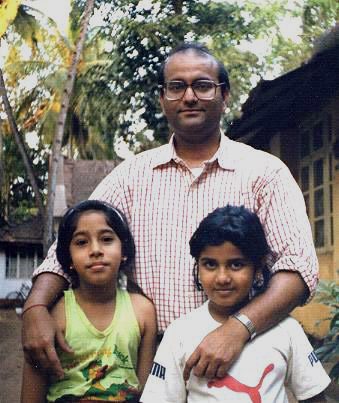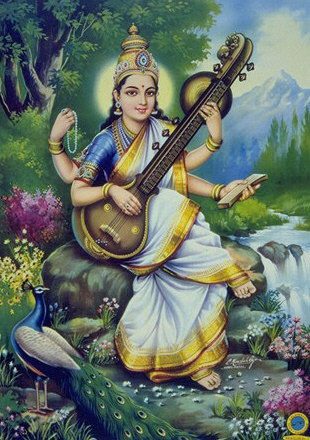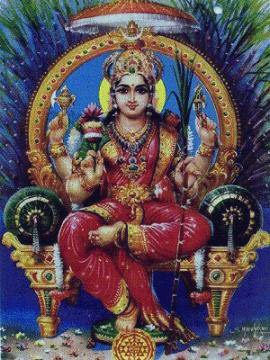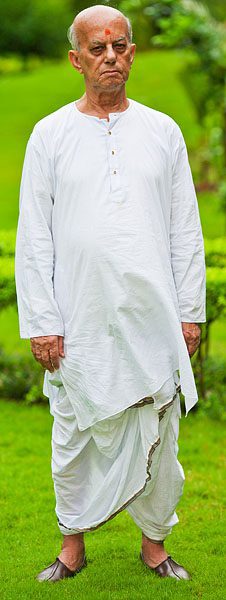by Rajan P. Parrikar
First published on SAWF on March 5, 2001

Rajan P. Parrikar (1995)
Raga Lalita-Gouri is a union of the eponymous Ragas Lalit and Gouri, named after the manifestations of the Divine Mother or Shakti. In the first two sections, the constituent ragas are first investigated in just enough detail to illuminate the essentials. We will then attain to the denouement, Lalita-Gouri, in the third and final segment.
Raga Lalit
This prachina raga is among the most influential members of the Hindustani community, for in it is embedded the seminal idea of the two madhyams placed cheek by jowl in intimate melodic communion. The quintessence of Lalit and its associated raganga – Lalitanga – is the coupling of the two madhyams. Subject to the type of dhaivat employed, Lalit is placed in either the Marwa that – shuddha dhaivat – or in the Poorvi that – komal dhaivat.
Marwa and Poorvi thats are, respectively, the Gamanashrama and Kamavardhini melakartas of the Carnatic paddhati. The shuddha dhaivat Lalit held sway in earlier times; in fact, Bhatkhande treats it as the canonical Lalit. The Lalit in currency today employs komal dhaivat and this version will be the focus of our discussion here.
Throughout this commentary, M = shuddha madhyam, m = teevra madhyam.

The Poorvi that is constituted from the following swara-set: S r G m P d N. Lalit drops the pancham altogether from the Poorvi set and then recruits shuddha madhyam for its key swara. The essence of Lalitanga is embedded in the following passage:
N’ r G M, G MmM, G, m G r S
Notice the langhan (skipping) of the shadaj en route to the shuddha madhyam. The M thus approached is a location for nyasa and it establishes the raga’s melodic ‘centre’. The second madhyam-laden cluster above expresses the core of Lalitanga: the two madhyams are intoned successively and ‘talk’ to each other. There will be occasion in almost all the clips to eavesdrop on this ‘conversation.’
The shuddha madhyam assumes the nyasa bahutva role, and dominates the proceedings in both the arohi and avarohi movements. In the interest of brevity, we shall focus on the main ideas; the subsidiary details may be inferred from the adduced recordings. A sample chalan of Lalit is formulated thus:
N’ r G M, mM G, m d, mdNS”, N r” N d m d mM, m G r S
It should be now obvious to even women and children that Lalit is a complex raga with a vakra build. A graha bhedam (also known as murchhana) on shuddha madhyam leads to an avirbhava of the Todi scale.
The M-m-M idea of Lalitanga is exploited in several other melodies – eg. Prabhat Bhairav, Bhankar and so on – although it must be emphasized that the mere presense of consecutive madhyams in itself does not establish Lalitanga: the key lies in the intonation and punctuation – uccharana, as it is called. For instance, ragas such as Nand and Kedar deploy consecutive madhyams on occasion but do not exhibit Lalitanga.
For this excursion we have marshalled a suite of outstanding samplers, several of them hard to come by.
Two film-based numbers inaugurate the proceedings. In both these clips Lata Mangeshkar is paired first with Mohammad Rafi and then with Manna Dey. Her felicity with Lalitanga leaves the two men looking like hapless rookies at a high school musical gathering.
First the popular favourite from LEADER, tuned skillfully by Naushad: ek shahenshah ne banwa ke haseen Taj Mahal.
From CHACHA ZINDABAD, music by Madan Mohan: preetama darasa dikhavo.
The touchstone of Lalit in the classical domain, the yardstick by which every other Lalit is measured – and mostly discarded – is this recording of Amir Khan, set in vilambit Jhoomra: kahan jage rata.
Another Lalit of great merit comes from Kesarbai Kerkar: ghutana lage raina.
A playful ‘Aftab-e-Mausiqui’ Faiyyaz Khan: tarapata hoon jaise jal bina meena.
Bade Ghulam Ali Khan erupts in a cannonade of tans in hum sanga tum sanga.
The shuddha dhaivat Lalit of yore is represented by Ulhas Kashalkar. There are occasional flashes of Hindol and Marwa but the main story is once again the instantiation of Lalitanga.
Raga Gouri
Gouri, too, is a prachina raga. Or to be more precise, it is a group of ragas. It would be appropriate to regard Gouri as a sub-melody, more in the line of a gesture than a full blown raganga. And so it is that there are Gouris of the Bhairav, Poorvi and Marwa thats with additional qualifiers such as the Shree-anga Gouri, Bhairav-anga Gouri, Poorvi-anga Gouri and so on. These are not considered ‘big’ ragas.

Most of the Gouris in vogue fall to either the Bhairav or the Poorvi that. The defining Gouri signature obtains from the peculiar behaviour on and around shuddha nishad of the mandra saptak. To wit:
S, N’ N’ S, r G, r S r N’, N’ d’ N’, N’ S
This lingering on the mandra nishad N’ and its angle of attack via r and d’ precipitate a distinct sensation. An additional artifact is the elongation of gandhar as indicated above. A soupçon of Shree-anga will also be noticed in many Gouris. That is all there is to this group of ragas under the “Gouri” rubric. The rest of the swaraspace past the gandhar is populated depending on your choice of that, anga and fancy. Every legal Indian citizen, therefore, is entitled to his or her personal Gouri. The curious are referred to Bhatkhande‘s rather detailed discourse on the subject in his classic work Hindustani Sangeet Paddhati.
Clipship ahoy! Watch out for the ritual enclosing the mandra nishad, or if you will, the ‘Gouritual.’
The first Gouri is of the Bhairav that. There is no Bhairavanga here but supporting structure is supplied by the scale-congruent Kalingada. Presenting His Horniness, Mr. Jasraj.
Gouri of the Poorvi that is rendered by C.R. Vyas via a composition of Jagannathbuwa Purohit “Gunidas”: khabariya le mori.
Bhimsen Joshi figures in this Marwa-that Gouri.
Another Marwa-that Gouri by Abdul Karim Khan.
Indian tradition would be nothing if not for the exceptions and escape clauses. We have none of the “my Book is the only true Book” and “my way is the only way” decrees prevalent in places west of the Arabian Sea. The final Gouri exhibit is a beautiful sample of Haveli Sangeet rendered by Amar Lal of the Kishangarh school. It is a different kind of Gouri, outside the canon, and is grounded in the Bhairav that, with a mild Bhairavanga, with both the komal nishad and shuddha rishab thrown in for good effect. The lyrics are attributed to Parmanand Swami (1493-1583).
Recordings of other Gouri varieties such as Ram Gouri, Kapar Gouri and so on have been bypassed for now.
Equipped with the fundamentals of Lalit and Gouri we now wish to inquire if the two can be conjoined in lawful wedlock.
Raga Lalita-Gouri
To recapitulate: the Lalitanga signature is fashioned from the close coupling of the two madhyams, the Gouri behaviour informed by appropriate clusters on and in the vicinity of the mandra nishad. It stands to reason that the definitive characteristics of any purposeful union of these two ragas must carry their respective genetic material. To what extent the stipulations are actually met in practice will be left as an exercise to the reader, as also recognition of supporting filler material (Poorvi, Pooriya Dhanashree, Kalingada, Shree etc).
The first item on the Lalita-Gouri platter has Ramashreya Jha “Ramrang” holding forth for 20 minutes in this recording made last month (February 2001) in Delhi specially for this feature. The development proceeds from ‘first principles’ and leads to the formulation of Lalita-Gouri, culminating in his own exquisite composition. The proceedings reveal why he is a peerless teacher, and a vidwan and musician of the highest class. He is supported on the harmonium by the veteran maestro from Goa, Tulshidas Borkar, and on the tabla by Mithilesh Kumar Jha.

Ramashreya Jha “Ramrang”
© Rajan P. Parrikar
Jha-sahab’s remarks on the bandish, its sahityic and swara features, are enshrined in the extended discussion above. From that mega-clip, we have isolated his composition in Lalita-Gouri. Notice how the raga lakshanas are elucidated in the first line itself: basana lalita sohe Gouri Amba ke.
Vinayakrao Patwardhan‘s version of Lalita-Gouri is the only one in this collection that aligns with the Bhairav-that Gouri. All the rest are Poorvi-that votaries. The composition is credited to Miyan Shouri, the originator of tappa: yara katara manu prema di.
Umrao Khan (son of sarangi-nawaz Bundu Khan of Delhi) sings a splendid bandish of “Manrang.” Although it has been labelled “Gouri” it is seen to exhibit Lalitanga and hence is included in this Lalita-Gouri section.
Lalita-Gouri is dear to the Agra clan. Vilayat Hussain Khan “Pranpiya” sings a composition of “Daras Piya” (Mehboob Khan, Faiyyaz Khan’s father-in-law). The raga characteristics of both Gouri and Lalit are captured in the first line itself: mora mana laga.
The next clip is offered for its vintage value despite its dubious audio quality: Altaf Hussain Khan of Khurja.
Vakra ragas such as these are primarily the playground for the vocalist. Occasionally an instrumentalist surpasses himself and compels us to take notice. This recording of Ali Akbar Khan is a masterly display with its meends, the shruti-pradhana nishad and so on. Although it is tempting to discuss the recording in more detail, Kabir’s immortal line – mana masta huwa taba kyon bole? – reins in my impulse.
Bhimsen Joshi generates a peculiar ‘swing’ around the mandra nishad in his khelana aaye Radha.
Although the composition preetama saiyyan darasa dikhaja is a staple of the Atrauli-Jaipur heavyweights, it is also treated with relish by the Agra folks as witness this clip of Pranpiya’s son, Younus Hussain Khan.
Kesarbai Kerkar‘s Lalita-Gouri transports us into the stratospheric regions we have come to associate with her name. There is a full-length live recording available. This clip is from a shorter performance: preetama saiyyan.
Gajananrao Joshi wields the same bandish but scarcely does justice to Gouri’s mandra nishad.
In the concluding item, Mallikarjun Mansur presents preetam saiyyan in vilambit Teental. The clip sparkles despite his son Rajsekhar‘s contaminating presence. The Lalitanga is presented upfront, the value accorded mandra nishad and gandhar hews to standard Gouritual. The tans are formulated with an eye on anchoring the action around nishad and gandhar. There can be no straight up and down sapat tans in Lalita-Gouri; they zigzag and keep bouncing off nishad as in PNNdNNmdNN. Mansur cobbles up marvellous swara-combinations, no doubt burnt into his memory through decades of relentless taleem.
Acknowledgements
Many thanks to Romesh Aeri, Ashok Ambardar, Ajay Nerurkar and Guri Singh. Anita Thakur, the soul of SAWF, is the reason I have kept at this.
